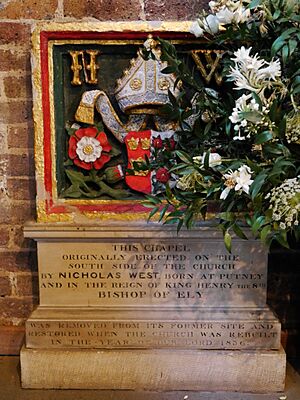St Mary's Church, Putney facts for kids
Quick facts for kids St. Mary's Church, Putney |
|
|---|---|

St. Mary's Church in 2014
|
|
| Location | Putney High Street, Putney, Greater London, SW15 1SN |
| Country | England |
| Denomination | Church of England |
| Churchmanship | Liberal Anglo-Catholic |
| Website | http://www.parishofputney.com/ |
| History | |
| Dedication | St Mary the Virgin |
| Architecture | |
| Heritage designation | Grade II* |
| Administration | |
| Parish | Putney |
| Deanery | Wandsworth |
| Archdeaconry | Wandsworth |
| Diocese | Southwark (Kingston Episcopal Area) |
| Province | Canterbury |
St. Mary's Church in Putney, London, is an old and important church. It stands right next to the River Thames and Putney Bridge. People have worshipped here for over 700 years. This church is famous because of the Putney Debates in 1647. These debates were a big part of the English Civil War. St. Mary's Church is also a special historic building, listed as Grade II*. This means it is very important and protected.
Contents
The Church Building: A Long History
The church building has changed a lot over time. Some parts are very old, from the Middle Ages. The tower, for example, was built in the 1400s. Some of the arches inside the main part of the church, called the nave, are also from that time.
Rebuilding and Changes
In the early 1500s, Bishop Nicholas West added a chapel. But most of the church you see today was rebuilt in 1836. An architect named Edward Lapidge designed the new parts. He used yellow bricks and stone. He also added tall, narrow windows. Some old medieval pillars were kept, but the main areas were made wider.
Fire and Restoration
In 1973, a fire badly damaged the church. It took almost ten years to rebuild it. The church was officially opened again in 1982. After the fire, the church's inside layout changed. The altar, which is a special table, is not at the very front. Instead, it is halfway down the side of the nave. The seats are arranged around it. Ronald Sims was the architect for this restoration. The church also has a large pipe organ made by a Danish company.
A Famous Quote
On one of the church walls, you can find a famous quote. It is from the Putney Debates of 1647. Colonel Thomas Rainsborough said:
For really I think that the poorest he that is in England hath a life to live, as the greatest he.
This quote means that everyone, no matter how poor, deserves to live and have rights, just like the richest people.
New Additions
In 2005, a new part of the church called the "Brewer Building" was opened. It cost a lot of money to build. St. Mary's is one of two churches in the area of Putney. The other is All Saints' Church, Putney Common.
People Connected to St. Mary's
Many interesting people have been linked to St. Mary's Church over the centuries.

Famous Visitors and Locals
- Samuel Pepys: He was a famous diarist in the 1600s. He wrote in his diary about visiting St. Mary's in 1667. He heard a good sermon there.
- Nicholas West: Born in Putney, he became a bishop and a diplomat. He built a beautiful chapel inside St. Mary's. He also built one in Ely Cathedral.
- Thomas Cromwell: He was born in Putney. He became a very powerful politician in the 1500s. He worked for King Henry VIII.
- Charles Dickens: This famous writer used St. Mary's as a setting in his novel David Copperfield. It's where the character David Copperfield gets married.

